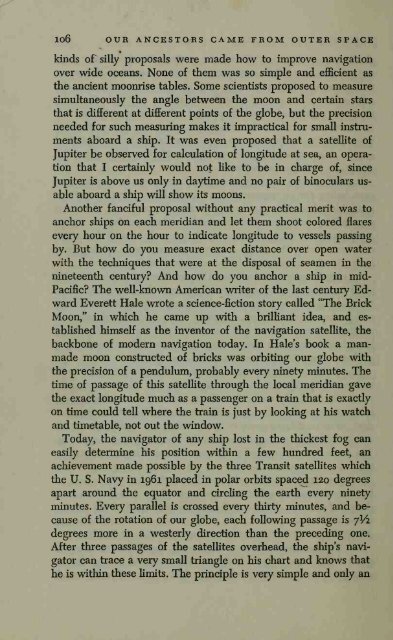Create successful ePaper yourself
Turn your PDF publications into a flip-book with our unique Google optimized e-Paper software.
106 OUR ANCESTORS CAME FROM OUTER SPACE<br />
kinds of silly proposals were made how to improve navigation<br />
over wide oceans. None of them was so simple and efficient<br />
as<br />
the ancient moonrise tables. Some scientists proposed to measure<br />
simultaneously the angle between the moon and certain stars<br />
that is different at different points of the globe, but the precision<br />
needed for such measuring makes it impractical for small instruments<br />
aboard a ship. It was even proposed that a satellite of<br />
Jupiter be observed for calculation of longitude at sea, an operation<br />
that I certainly would not Uke to be in charge of, since<br />
Jupiter is above us only in daytime and no pair of binoculars usable<br />
aboard a ship will show its moons.<br />
Another fanciful proposal without any practical merit was to<br />
anchor ships on each meridian and let them shoot colored flares<br />
every hour on the hour to indicate longitude to vessels passing<br />
by. But how do you measure exact distance over open water<br />
with the techniques that were at the disposal of seamen in the<br />
nineteenth century? And how do you anchor a ship in mid-<br />
Pacific? The well-known American writer of the last century Edward<br />
Everett Hale wrote a science-fiction story called "The Brick<br />
Moon," in which he came up with a brilliant idea, and established<br />
himself as the inventor of the navigation satellite, the<br />
backbone of modern navigation today. In Hale's book a manmade<br />
moon constructed of bricks was orbiting our globe with<br />
the precision of a pendulum, probably every ninety minutes. The<br />
time of passage of this satellite through the local meridian gave<br />
the exact longitude much as a passenger on a train that is exactly<br />
on time could tell where the train is just by looking at his watch<br />
and timetable, not out the window.<br />
Today, the navigator of any ship lost in the thickest fog can<br />
easily determine his position within a few hundred feet, an<br />
achievement made possible by the three Transit satellites which<br />
the U. S. Navy in 1961 placed in polar orbits spaced 120 degrees<br />
apart around the equator and circling the earth every ninety<br />
minutes. Every parallel is crossed every thirty minutes, and because<br />
of the rotation of our globe, each following passage is<br />
degrees more in a westerly direction than the preceding one.<br />
After three passages of the satellites overhead, the ship's navigator<br />
can trace a very small triangle on his chart and knows that<br />
he is within these limits. The principle is very simple and only an<br />
7V2

















